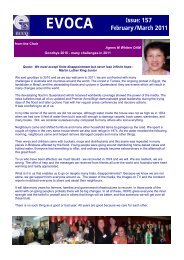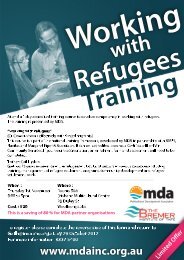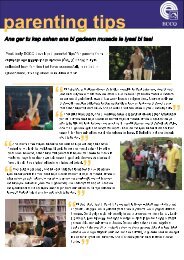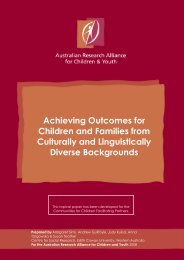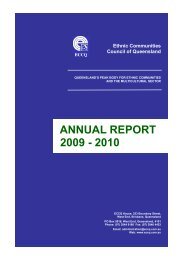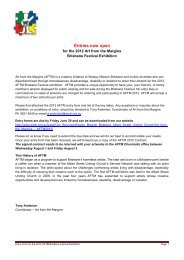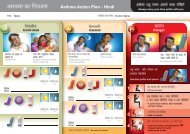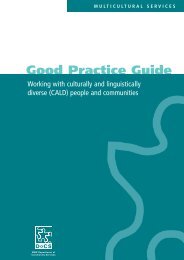ANNUAL REPORT
Annual-Report-2004-2.. - Ethnic Communities Council Queensland
Annual-Report-2004-2.. - Ethnic Communities Council Queensland
- No tags were found...
You also want an ePaper? Increase the reach of your titles
YUMPU automatically turns print PDFs into web optimized ePapers that Google loves.
THE ETHNIC COMMUNITIES COUNCIL OF QUEENSLAND<br />
ACN 010 151 256<br />
NOTES TO THE FINANCIAL STATEMENTS FOR THE YEAR ENDED 30 JUNE 2005<br />
NOTE 1: STATEMENT OF SIGNIFICANT ACCOUNTING POLICIES (continued)<br />
(d) Intangibles<br />
Goodwill<br />
Balances are reviewed annually and any balance representing future benefits the realisation of which is considered no longer<br />
probable is written off.<br />
(e) Employee Benefits<br />
Provision is made for the company's liability for employee benefits arising from services rendered by employees to balance date.<br />
Employee benefits expected to be settled within one year together with benefits arising from wages and salaries, annual leave and<br />
sick leave which will be settled after one year, have been measured at the amounts expected to be paid when the liability is<br />
settled. Other employee benefits payable later than one year have been measured at the current value of the estimated future cash<br />
outflows to be made for those benefits.<br />
Contributions are made by the company to an employee superannuation fund and are charged as expenses when incurred.<br />
(f) Cash<br />
For the purposes of the Statement of Cash Flows, cash includes cash on hand and at call deposits with banks or financial<br />
institutions, investments in money market instruments maturing within less than two months and net of bank overdrafts.<br />
(g) Revenue<br />
Interest revenue is recognised on a proportional basis taking into account the interest rates applicable to the financial assets.<br />
Other revenue is recognised when the right to receive the revenue has been established. Revenue from grants must be utilised as<br />
detailed in the grant budget. Residual grant money over $300 must be repaid. All revenue is stated net of the amount of goods and<br />
services tax (GST).<br />
(h) Goods & Services Tax (GST)<br />
Revenues, expenses and assets are recognised net of the amount of GST, except where the amount of GST incurred is not recoverable<br />
from the Australian Taxation Office. In these circumstances the GST is recognised as part of the cost of acquisition of the<br />
asset or as part of an item of expense. Receivables and payables in the Statement of Financial Position are shown inclusive of<br />
GST.<br />
(i) Comparative Figures<br />
Where required by Accounting Standards comparative figures have been adjusted to conform with changes in presentation for the<br />
current financial year.<br />
(j) Impact of Adoption of Australian Equivalents to International Financial Reporting Standards<br />
The company is preparing and managing the transition to Australian Equivalent of International Financial Reporting Standards<br />
(AIFRS) effective for financial years commencing from 1 January 2005. The adoption of AIFRS will be reflected in the<br />
company's financial statements for the year ending 30 June 2006. On first time adoption of AIFRS, comparatives for the financial<br />
year ended 30 June 2005 are required to be restated. The majority of the AIFRS transitional adjustments will be made<br />
retrospectively against retained earnings at 1 July 2004.<br />
The company and its auditors have assessed the significance of the expected changes and are preparing for their implementation.<br />
An AIFRS committee is overseeing and managing the company's transition to AIFRS. The impact of the alternative treatments<br />
and elections under AASB1: First Time Adoption of Australian Equivalents to International Financial Reporting Standards has<br />
been considered where applicable. It is noted that as the company is a not‐for‐profit, many of the AIFRS standards are not<br />
applicable.<br />
The directors have decided to apply the exemption provided in AASB 1 First‐time Adoption of Australian Equivalents to International<br />
Financial Reporting Standards which permits entities not to apply the requirements of AASB 132 Financial Instruments:<br />
Presentation & Disclosures, and AASB 139 Financial Instruments: Recognition & Measurement for the financial year ended 30<br />
June 2005. The standards will be applied from 1 July 2005. The directors are determining the impact that adopting the standards<br />
would have on the financial statements of the company. The directors are of the opinion that the key material differences in the<br />
company's accounting policies on conversion to AIFRS and the financial effect of these differences where known are as follows.<br />
Users of the financial statements should, however, note that the amounts disclosed could change if there are any amendments by<br />
standard‐setters to the current AIFRS, or interpretation of the AIFRS requirements changes from the continued work of the<br />
company.<br />
38 ECCQ Annual Report 2004-2005



